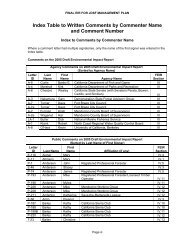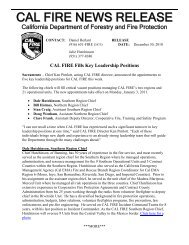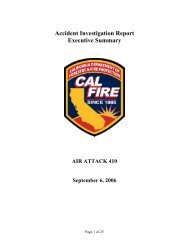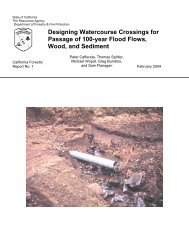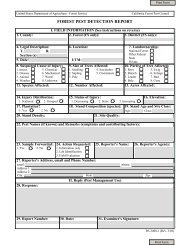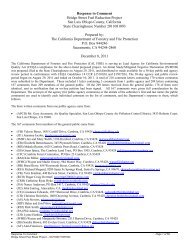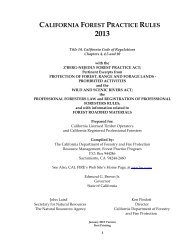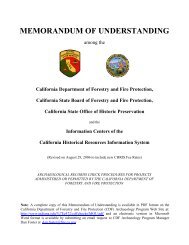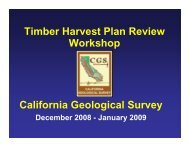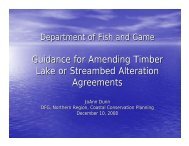Boggs Mountain Demonstration State Forest Draft ... - Cal Fire
Boggs Mountain Demonstration State Forest Draft ... - Cal Fire
Boggs Mountain Demonstration State Forest Draft ... - Cal Fire
Create successful ePaper yourself
Turn your PDF publications into a flip-book with our unique Google optimized e-Paper software.
<strong>Boggs</strong> <strong>Mountain</strong> <strong>Demonstration</strong> <strong>State</strong> <strong>Forest</strong> <strong>Draft</strong> Management Plan, June 2008<br />
Detailed Information on How to Sort the Station Index File<br />
A Registered Professional <strong>Forest</strong>er working on a company ownership will likely be interested in<br />
rainfall data from one to several counties in <strong>Cal</strong>ifornia. We suggest the following procedure for<br />
quickly locating available stations within a given county:<br />
‣ Open the Station Index Excel file on the DWR Climate webpage, located under “Rainfall<br />
Depth-Duration-Frequency Data (preliminary).”<br />
‣ Save the Station Index file to your personal computer (must save it to be able to sort).<br />
‣ From the menu tool bar, select “Data” and click on “Sort.”<br />
‣ Highlight the entire spreadsheet, except the initial row displaying header information<br />
(4906 rows).<br />
‣ Sort by columns I (county [sort ascending]), L (latitude [sort descending]), and K<br />
(longitude [sort descending]) [or other desired attributes].<br />
‣ Save the revised file to your hard drive.<br />
The result of this sorting is a file in which the stations are sorted by county, and under each<br />
county, they are listed from north to south, and for any given latitude, from east to west. If you<br />
get the approximate latitude and longitude for the crossing site, then you can easily go to the<br />
correct county and identify the station(s) in that county that are closest to the crossing site. Note<br />
that not all of the stations in the index will have hourly depth-duration-frequency data. Then one<br />
can open the correct folder under Rain H DDF Hourly on the website and compare the available<br />
stations with hourly data in the county of interest to the list of stations from the Station Index file.<br />
Once the Station Index file is downloaded, saved, and sorted as above, the RPF can remove all<br />
of the stations that will not be needed. Also, if the RPF works in a specific area, the list of<br />
stations for that area (e.g., Trinity County) can be printed out for future reference so that one does<br />
not always have to open up the file – one can just look at the printed list and then go to the<br />
database on the web and get the data.<br />
86



